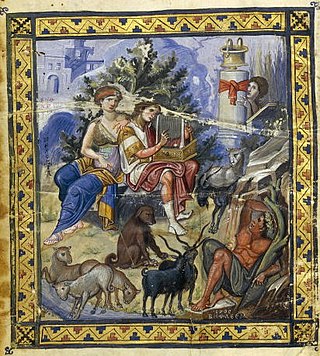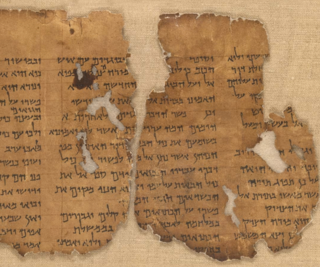
The Book of Psalms, also known as the Psalms, or the Psalter, is the first book of the Ketuvim ("Writings"), the third section of the Tanakh, and a book of the Old Testament. The title is derived from the Greek translation, ψαλμοί, meaning "instrumental music" and, by extension, "the words accompanying the music". The book is an anthology of individual Hebrew religious hymns, with 150 in the Jewish and Western Christian tradition and more in the Eastern Christian churches. Many are linked to the name of David, but modern mainstream scholarship rejects his authorship, instead attributing the composition of the psalms to various authors writing between the 9th and 5th centuries BC. In the Quran, the Arabic word ‘Zabur’ is used for the Psalms of David in the Hebrew Bible.

The Septuagint, sometimes referred to as the Greek Old Testament or The Translation of the Seventy, and often abbreviated as LXX, is the earliest extant Greek translation of the Hebrew Bible from the original Hebrew. The full Greek title derives from the story recorded in the Letter of Aristeas to Philocrates that "the laws of the Jews" were translated into the Greek language at the request of Ptolemy II Philadelphus by seventy-two Jewish translators—six from each of the Twelve Tribes of Israel.

The Dead Sea Scrolls are ancient Jewish and Hebrew religious manuscripts discovered between 1946 and 1956 at the Qumran Caves in what was then Mandatory Palestine, near Ein Feshkha in the West Bank, on the northern shore of the Dead Sea. Dating from the 3rd century BCE to the 1st century CE, the Dead Sea Scrolls are considered to be a keystone in the history of archaeology with great historical, religious, and linguistic significance because they include the oldest surviving manuscripts of entire books later included in the biblical canons, along with deuterocanonical and extra-biblical manuscripts which preserve evidence of the diversity of religious thought in late Second Temple Judaism. At the same time they cast new light on the emergence of Christianity and of Rabbinic Judaism. Most of the scrolls are held by Israel in the Shrine of the Book at the Israel Museum, but their ownership is disputed by Jordan due to the Qumran Caves' history: following the End of the British Mandate for Palestine in 1947, Jordan occupied the area in the 1948 Arab–Israeli War, and Israel captured both the area and several Scrolls from Jordan in the 1967 Six Day War. However, some of the scrolls are still in Jordan and are now displayed at The Jordan Museum in Amman. Ownership of the scrolls is also contested by the State of Palestine.

Pesher, from the Hebrew root meaning "interpretation," is a group of interpretive commentaries on scripture. The pesharim commentaries became known from the discovery of the Dead Sea Scrolls. The pesharim give a theory of scriptural interpretation of a number of biblical texts from the Hebrew Bible, such as Habakkuk and Psalms.

Psalm 151 is a short psalm found in most copies of the Septuagint (LXX), but not in the Masoretic Text of the Hebrew Bible. The title given to this psalm in the Septuagint indicates that it is supernumerary, as no number is affixed to it. The psalm is ascribed to David. It is also included in some manuscripts of the Peshitta. The psalm concerns the story of David and Goliath.
Psalms 152 to 155 are additional Psalms found in two Syriac biblical manuscripts to date and several manuscripts of Elijah of Anbar's "Book of Discipline", first identified by the orientalist librarian Giuseppe Simone Assemani in 1759. Together with Psalm 151 they are also called the Five Apocryphal Psalms of David or the "Five Syriac Psalms".
Emanuel Tov, is a Dutch–Israeli biblical scholar and linguist, emeritus J. L. Magnes Professor of Bible Studies in the Department of Bible at the Hebrew University of Jerusalem. He has been intimately involved with the Dead Sea Scrolls for many decades, and from 1991, he was appointed Editor-in-Chief of the Dead Sea Scrolls Publication Project.

Psalm 145 is the 145th psalm of the Book of Psalms, generally known in English by its first verse, in the King James Version, "I will extol thee, my God, O king; and I will bless thy name for ever and ever". In Latin, it is known as "Exaltabo te Deus meus rex". It is the last psalm in the final Davidic collection of psalms, comprising Psalms 138 to 145, which are specifically attributed to David in their opening verses.
The Thanksgiving Scroll was one of the first seven Dead Sea Scrolls discovered in 1947 by the Bedouin. The scroll gets its name from the recurring use of the phrase "I thank you" in many of the poems. The Hebrew word Hodayot refers to "thanks" or "thanksgiving". Other names include Thanksgiving Hymns, Thanksgiving Psalms, Hymns Scroll and Scroll of Hymns.
4Q108 is a fragment containing a portion of the Song of Songs (3:7–8) in Hebrew. Fragments from three such scrolls were found in Cave 4 at Qumran. These, and 6Q6 from Cave 6, estimated from 2nd century BCE, comprise the total witness to the Song from the Dead Sea Scrolls, known so far.
Discoveries in the Judaean Desert (DJD) is the official 40-volume publication that serves as the editio princeps for the Dead Sea Scrolls. It is published by Oxford University Press.
"They have pierced my hands and my feet", or "They pierced my hands and my feet" is a phrase that occurs in some English translations of Psalm 22:16. The text of the Hebrew Bible is obscure at this point, and Jewish and some Christian commentators translate this line differently, although there is no evidence of a deliberate mistranslation.
The Isaiah Scroll, designated 1QIsaa and also known as the Great Isaiah Scroll, is one of the seven Dead Sea Scrolls that were first discovered by Bedouin shepherds in 1946 from Qumran Cave 1. The scroll is written in Hebrew and contains the entire Book of Isaiah from beginning to end, apart from a few small damaged portions. It is the oldest complete copy of the Book of Isaiah, being approximately 1000 years older than the oldest Hebrew manuscripts known before the scrolls' discovery. 1QIsaa is also notable in being the only scroll from the Qumran Caves to be preserved almost in its entirety.
The Samuel scroll is a collection of four manuscript fragments containing parts of the Book of Samuel which were found among the Dead Sea Scrolls.

Habakkuk 3 is the third chapter of the Book of Habakkuk in the Hebrew Bible or the Old Testament of the Christian Bible. This book contains the prophecies attributed to the prophet Habakkuk, and is a part of the Book of the Twelve Minor Prophets. This chapter records "Habakkuk's song", a poetic psalm "extolling God's triumphs."

Jeremiah 17 is the seventeenth chapter of the Book of Jeremiah in the Hebrew Bible or the Old Testament of the Christian Bible. This book contains prophecies attributed to the prophet Jeremiah, and is one of the Books of the Prophets. This chapter includes the third of the passages known as the "Confessions of Jeremiah".










